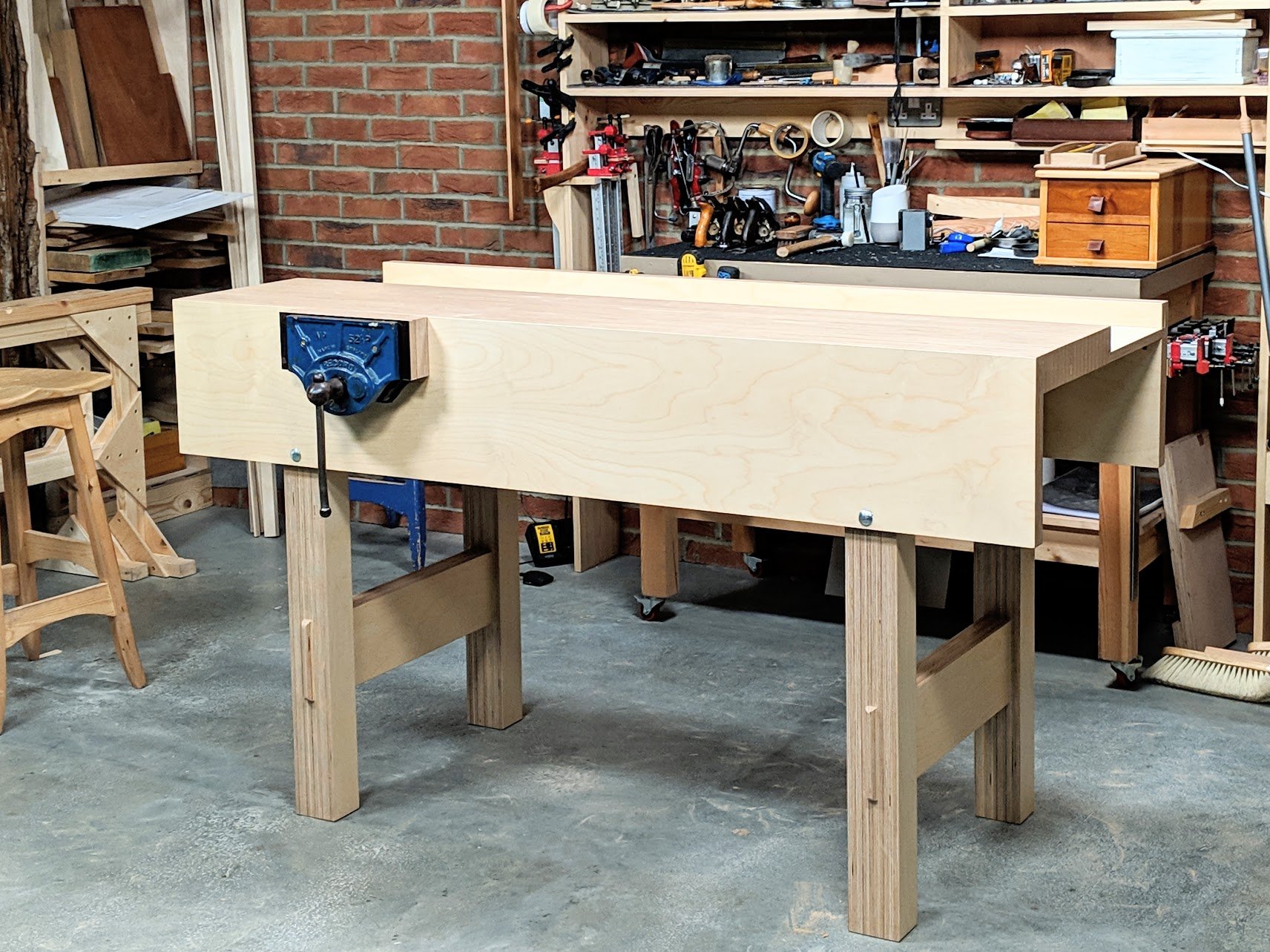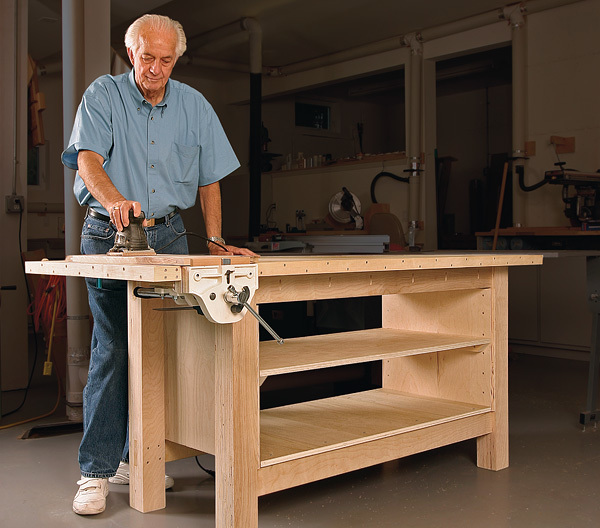Are you wondering what type of plywood to use for your workbench? Well, you’ve come to the right place! Choosing the right plywood for your workbench is crucial for its durability and functionality. Whether you’re a seasoned woodworker or just starting out, this article will provide you with all the information you need to make an informed decision.
When it comes to workbenches, plywood is a popular choice due to its strength and affordability. But with so many options available, it can be overwhelming to know which one is the best fit for your needs. That’s where we come in! We’ll break down the different types of plywood and help you understand which one will work best for your workbench project.
So, grab your toolbelt and get ready to dive into the world of plywood as we guide you through the process of choosing the perfect plywood for your workbench. Let’s get started!

The Best Plywood for Your Workbench: A Comprehensive Guide
Introduction: When it comes to building a workbench, choosing the right plywood is crucial. Your workbench needs to be sturdy, durable, and able to withstand heavy loads. In this comprehensive guide, we will explore the different types of plywood available, their advantages, and factors to consider before making a decision. Whether you’re a professional woodworker or a beginner DIY enthusiast, this article will help you determine the best plywood for your workbench.
Factors to Consider When Choosing Plywood for Your Workbench
Choosing the right plywood for your workbench involves considering several important factors. Here are the key elements to keep in mind:
1.
Durability and Strength
One of the crucial factors to consider is the durability and strength of the plywood. You need a material that can withstand heavy loads, resist warping, and endure the wear and tear of daily use. Hardwood plywood, such as birch or oak, is a popular choice due to its high density and resilience. It is less prone to denting and can handle heavy tools and equipment with ease.
Another option is oriented strand board (OSB), which is made from compressed wood strands. While OSB is not as visually appealing as hardwood plywood, it offers excellent strength and durability at a lower cost. It can be a suitable choice if aesthetics are not a top priority.
2.
Moisture Resistance
If your workbench will be exposed to moisture or used in humid environments, it’s essential to choose plywood that is moisture-resistant. Marine-grade plywood is specifically designed for such conditions. It is constructed with waterproof glue and has fewer voids in the layers, making it highly resistant to water damage. This type of plywood is commonly used in boat building but is also suitable for workbenches in damp areas, such as garages or basements.
3.
Size and Thickness
Consider the size and thickness of the plywood sheets you will need for your workbench. Standard plywood sheets are typically 4×8 feet, but other sizes are also available. The thickness of the plywood will depend on the weight-bearing capacity you require. Thicker plywood, such as 3/4 inch or 18mm, is suitable for heavy-duty workbenches that will hold large tools and machinery. Thinner plywood, such as 1/2 inch or 12mm, may be sufficient for lighter applications.
Types of Plywood for Workbenches
After considering the factors mentioned above, it’s time to explore the different types of plywood suitable for workbenches. Here are some popular options:
1.
Hardwood Plywood
Hardwood plywood is a versatile choice for workbenches. It is made from layers of hardwood veneers bonded together with waterproof glue, creating a durable and stable panel. Birch plywood is a popular hardwood option due to its excellent strength and smooth surface. Oak plywood is another common choice known for its durability and attractive grain pattern. Hardwood plywood is more expensive than other types but offers superior quality.
2.
Oriented Strand Board (OSB)
OSB is an engineered wood product made by compressing wood strands together with adhesive. It is an affordable alternative to hardwood plywood and offers reliable strength and durability. OSB panels are available in various thicknesses and can withstand heavy loads. However, they are not as aesthetically pleasing as hardwood plywood and may require additional finishing if you desire a more polished look.
3.
Particle Board
While not as sturdy as plywood, particle board can still be a viable option for lightweight workbenches or temporary setups. It is composed of wood particles combined with synthetic resins and compressed under high pressure. Particle board is affordable and widely available but is susceptible to moisture damage and not as durable as plywood. It may require reinforcement or more frequent replacement if subjected to heavy use.
4.
Medium-Density Fiberboard (MDF)
MDF is another engineered wood product, made by breaking down hardwood or softwood residuals into wood fibers and combining them with wax and resin binders. It offers a smooth and uniform surface, making it suitable for workbenches where precision is essential. However, MDF is not as strong as plywood and is susceptible to moisture damage. It is ideal for lighter applications and should be protected from moisture with proper sealing or coating.
Finding the Right Plywood for Your Workbench
Now that we have discussed the different types of plywood suitable for workbenches, it’s time to consider your specific needs and preferences. Here are some additional tips to help you make an informed decision:
1. Determine your budget: Consider your budgetary constraints and choose a plywood type that fits within your financial limitations. Remember to balance cost with the desired durability and quality.
2. Assess your workbench requirements: Evaluate the weight-bearing capacity, the tools or equipment you will be using, and the overall purpose of your workbench. This will help you determine the appropriate thickness and strength of the plywood.
3. Consider your workspace: Take into account the environmental conditions of your workspace, such as humidity levels or exposure to moisture. Opt for a plywood type that can withstand these conditions without compromising performance.
4. Seek professional advice: If you’re unsure about the best plywood for your specific workbench needs, consult with professionals or experienced woodworkers who can provide valuable insights based on their expertise.
In conclusion, selecting the right plywood for your workbench involves considering various factors such as durability, moisture resistance, size, and type. Hardwood plywood, OSB, particle board, and MDF are all viable options, each with its own advantages and disadvantages. Assessing your budget, workbench requirements, workspace conditions, and seeking expert advice can help you make an informed decision. By carefully selecting the appropriate plywood, you can build a workbench that is not only functional but also durable and reliable, providing you with a solid foundation for your woodworking projects.
Key Takeaways: What Plywood to Use for Workbench?
- Consider using 3/4-inch thick plywood for added strength and durability.
- Choose plywood with a smooth and flat surface to provide a stable workbench top.
- Opt for a plywood grade with minimal voids and defects to ensure a solid work surface.
- Select plywood that is moisture-resistant or treated for better longevity in a workshop environment.
- Check the load-bearing capacity of the plywood to ensure it can support the weight of your projects.
Frequently Asked Questions
When it comes to building a workbench, choosing the right plywood is crucial for its durability and functionality. Here are some common questions asked about plywood selection for workbenches:
1. What qualities should I look for in plywood for a workbench?
When selecting plywood for a workbench, there are a few key qualities to consider. First, opt for a plywood with a thick core, such as birch or oak, to ensure strength and stability. Look for plywood with minimal voids or gaps, as this will provide a smoother work surface. Additionally, consider the grade of plywood – for a workbench, a C-grade or better is recommended for better surface quality.
It’s also worth considering the moisture resistance of the plywood. If your workbench may be exposed to moisture or damp conditions, choose a plywood with exterior-grade glue or a higher moisture-resistant rating to prevent warping or delamination.
2. Can I use any type of plywood for a workbench?
While there are various types of plywood available, not all are suitable for use as a workbench. Avoid using plywood that is too thin or has a low-quality core, as it may not provide enough stability for heavy-duty work. Additionally, plywood with a lot of voids or gaps could compromise the integrity of the workbench.
It’s best to choose plywood specifically designed for structural applications, such as birch or oak plywood. These types of plywood are known for their strength, stability, and resistance to wear and tear, making them ideal for workbench construction.
3. Is plywood with a veneer surface suitable for a workbench?
Plywood with a veneer surface can be suitable for a workbench, but it depends on the type of veneer and the intended use of the workbench. If you plan to do heavy-duty work or use power tools, it’s advisable to choose plywood with a thicker veneer or a solid wood surface. This will provide better durability and resistance to wear and tear.
However, if your workbench will primarily be used for lighter tasks or as a crafting table, plywood with a thin veneer surface can still offer a smooth work surface. Just ensure that the veneer is securely bonded to the plywood core to prevent peeling or chipping.
4. Can I save money by using lower-grade plywood for a workbench?
While it may be tempting to save money by using lower-grade plywood for a workbench, it’s important to consider the long-term durability and functionality of the workbench. Lower-grade plywood may have more voids, gaps, or weaker cores, which could compromise the strength and stability of the workbench.
Investing in higher-grade plywood or structural plywood specifically designed for workbenches will ensure a more rigid and durable work surface. It will also provide better resistance to wear and tear, allowing your workbench to withstand heavy-duty tasks over time.
5. Are there any alternatives to plywood for building a workbench?
Yes, there are alternatives to plywood for building a workbench. One popular alternative is solid wood, such as hardwood planks or beams. Solid wood offers excellent durability and stability, but it can be more expensive compared to plywood.
Another alternative is medium-density fiberboard (MDF), which is a dense engineered wood product. MDF provides a smooth and flat work surface, but it may not be as sturdy as plywood or solid wood. It’s best suited for lighter tasks or as a temporary workbench.

The Paul Sellers Plywood Workbench | Episode 1
Summary
When choosing the right plywood for your workbench, there are a few important factors to consider. First, you need to make sure the plywood is sturdy and durable enough to handle heavy loads and withstand wear and tear. Look for plywood with a high grade or rating, such as A or B. Additionally, consider the thickness of the plywood, with 3/4 inch being a common and suitable choice. Finally, pay attention to the type of plywood, such as CDX or MDO, which can affect its strength and performance. By keeping these factors in mind, you can select the right plywood for your workbench.
It’s also essential to properly prepare and finish the plywood to ensure its longevity and functionality. Apply a protective finish, such as polyurethane, to shield the plywood from moisture and other potential damages. Sanding and sealing the edges can help prevent splintering and increase the overall strength of the workbench. Lastly, consider reinforcing the plywood with added support, such as metal brackets or framing, to enhance its stability. These simple steps will help you create a sturdy and reliable workbench that can withstand heavy use.
